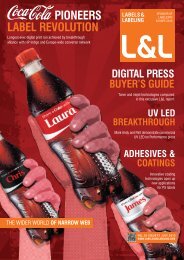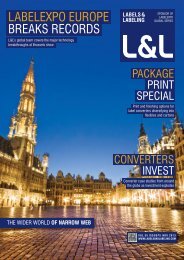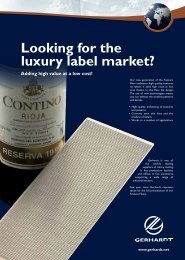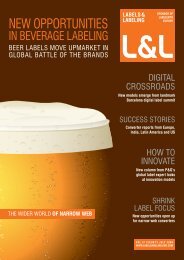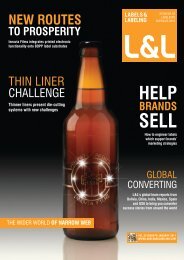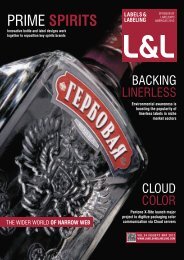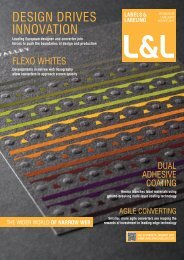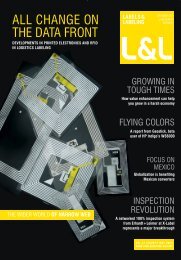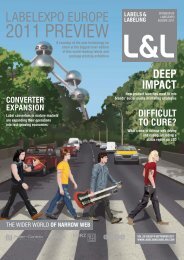Create successful ePaper yourself
Turn your PDF publications into a flip-book with our unique Google optimized e-Paper software.
88<br />
Defining Argentine wine<br />
LABEL <strong>DESIGN</strong> has proved decisive in promoting brands in the fiercely competitive Argentine wine market, as<br />
Guillermo Dufranc at design agency Tridimage explains<br />
While Argentine wine is known throughout the world for its high<br />
quality, it has only been in the last 25 years that the country<br />
has produced a consumer society which supports wines with a<br />
wide range of prices, from entry-level to ultra-premium wines.<br />
To better understand the recent changes in the market,<br />
it is important to know about its history. Wine is part of the<br />
Argentine culture and has always been present when family<br />
and friends get together. Twenty years ago choosing a bottle of<br />
wine was a simple task, as there were only red or white wine,<br />
and big bottles of five liters – known as damajuanas – were very<br />
popular. Wine was usually diluted with sparkling water, so the<br />
quality was not very important for most consumers.<br />
The market has evolved in the last few years when a wide<br />
variety of wines such as Malbec, Cabernet Sauvignon, Syrah,<br />
Chardonnay were launched. This segment is well established<br />
and today it is stronger than the classic red and white wine.<br />
When wine became fashionable, traditional consumers learnt<br />
more about wine tasting. Moreover, there was a massive interest<br />
in wine from new consumers more open to new varieties.<br />
The graphic style of Argentine wine labels has always been<br />
influenced by the heritage of the Old World wines coming from<br />
European tradition. The presence of classic typography and<br />
sober designs is their most remarkable characteristic, and<br />
this has informed today’s contemporary graphic language. In<br />
that sense, the Argentine wine market is rather conservative<br />
compared to other new world producers.<br />
Consumers have become more selective and careful when<br />
choosing wine, thus the label message needs to be very clear<br />
and precise, since the graphic design conveys its values. If<br />
a label design seems more expensive than its actual price, it<br />
could be considered deceitful; the same is said when a wine is<br />
more expensive than what its label communicates.<br />
If a brand does not have a story, a story must be created,<br />
conceived to fulfill the brand’s strategic objectives. Having<br />
defined the brand story, the next step is to find the most<br />
suitable concept and graphic universe that will help to tell that<br />
story. Design will translate graphically what the brand wants<br />
to convey. Every detail needs to be conscientiously thought;<br />
typography, color, paper texture, metallic foils, gloss spot and<br />
emboss. Every design element must be applied to make a bold<br />
and strong brand statement and achieve shelf impact.<br />
LABELS&LABELING<br />
Bodega Privada means ‘Private Cellar’ in Spanish. In this<br />
case we were inspired by the idea that these wines are part<br />
of a private collection. A kind of club that keeps its secrets<br />
locked away. To enter the cellar, the consumer should find the<br />
appropriate key. The textured paper contrasts with the relief and<br />
brightness of the shinny gloss spot lacquer, highlighting the<br />
artwork of the twelve keys that were specially designed for the<br />
collection. In every label the keys are combined in a different<br />
way. This supports the idea that each wine varietal is unique.<br />
Ricordi is a tribute to the founder of the RPB winery. He was<br />
an Italian immigrant, who arrived in Argentina with little more<br />
than his dreams, and thanks to his vision, founded a thriving<br />
business. The label design should be both emotional and<br />
respectful. Italian stamps transport us back to the times when<br />
postcards were the only way to be in contact with relatives<br />
who remained in their home country. The engravings represent<br />
the high quality craftsmanship of the wines and the signature<br />
highlights the personality of the founder. The textured paper<br />
also conveys a warm and nostalgic feeling.<br />
When creating the brand identity and label design for<br />
Callejón del Crimen (Crime Alley), Tridimage's challenge<br />
consisted of conveying the particular attributes of the brand.<br />
For the Evidencia (Evidence) line, a fingerprint in silver ink<br />
becomes a subtle reference to the brand's mysterious story,<br />
based on real facts that have taken place near the vineyards.<br />
For the ultra-premium Misterio (Mystery) line a chiaroscuro<br />
communicates the brand story.<br />
Wine labels are not only elegant logos and nice graphics.<br />
Wine brands are built on their values and on the way<br />
consumers feel connected with them. This is why it is so<br />
important to define a brand story, a concept that defines the<br />
product. The absence of concepts leads to a generic label,<br />
a graphic template with no personality, without direction. It is<br />
not possible to design a wine with personality without having a<br />
clear idea of the brand message to convey.<br />
ABOUT THE AUTHOR<br />
Guillermo Dufranc is graphic design coordinator at the Tridimage 3D<br />
brand and package design agency based in Buenos Aires, Argentina.<br />
Since 1995 the company has helped shape world-class elite brands in<br />
the wine sector.



